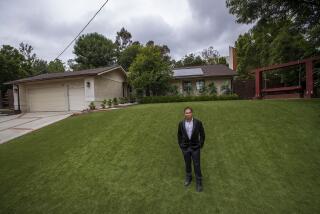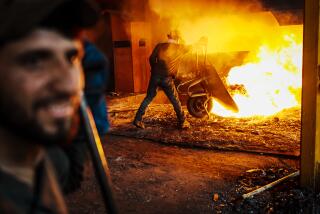Architect’s Gift to His War-Torn Afghanistan Is ‘Village of Hope’
Some people design dream homes. Masum Azizi has a broader vision: a dream village in Afghanistan that would house hundreds of homeless displaced by earthquakes, war and two decades of unrest.
The Newport Beach architect has devoted six months to a project he calls “The Village of Hope.” He set aside other business, paid several environmental planners and staff members at his firm to help, and donated his personal time to design energy-efficient and quake-proof shelters.
“I’ve lived in this country since 1980, but the first half of my life, I kind of owe it to Afghanistan,” said Azizi, 46. “The least I can do is come up with a way to help people.... A lot of people get overwhelmed. They say, ‘No, it’s not going to work. It’s not possible.’ But I think it’s very possible. I believe it can be built.”
The concept involves a 2-square-mile grid that can be developed in sections. It could include homes, a school, a mosque, an orphanage and green areas. Each small home would be built with local building materials such as an adobe-styled clay brick. All the homes would be accessible to the disabled, and each would be within walking distance of a school.
The design incorporates traditional features, including a cooling system called baddgeer, which uses an opening on the roof to draw in air and push it into the home, and an oven, or tanoor, which doubles as a heating system with underground channels that warm stone slabs on the floor.
Azizi recently finished the design but plans to spend several months completing blueprints that will show, brick by brick, how to prepare the clay material.
He has enlisted the help of 2,000 skilled masons, bricklayers and construction workers in Pakistan and Iran. “They’re willing to work, and they’re very anxious to start,” Azizi said.
He is eagerly trying to get the project off the ground. He has made presentations to politicians and hopes to present the plan to the United Nations, the World Bank and other major aid organizations that could help implement it.
He estimates that a small home, built in 35 days by four workers, would cost $5,500. Later, with practice, it would take 17 days and cost $4,500, he believes.
Environmental planner Debra Einstein said she has watched the project gain momentum, from just an idea and a few sketches to detailed plans.
“What got me so excited is Masum’s enthusiasm,” Einstein said. “This is homeland. This is where he’s from. Even in the beginning processes when he was talking about the project, I immediately got excited.”
It might be Azizi’s enthusiasm or the wistful manner in which he recalls his country. Environmental planner Nicole Morse said Azizi’s eyes light up when he talks about the Village of Hope and invokes childhood memories.
When Azizi went to graduate school in Copenhagen, he left behind a family of builders and a lush country with burgeoning development.
Young professionals were being urged into fields such as construction, engineering and architecture.
He remembers the first time he walked by the National Museum in Afghanistan. He was 6 years old, on his way to school, when his father pointed to the magnificent building and told him, “Your grandpa built that.”
He would proudly pass the museum every day, sometimes running his hands across the stone wondering if his grandfather’s hands had touched the same spot.
And he felt safe at school, as if he could feel his grandfather’s presence.
But now, Azizi points at a photo of the crumbling museum, nearly destroyed by bombs and rocket attacks. “Look at what they did to my grandpa,” Azizi said.
He is ready to return to a country he probably won’t recognize after years of warfare. He’ll do it to help build his village. All he needs is a few more dreamers.
More to Read
Sign up for Essential California
The most important California stories and recommendations in your inbox every morning.
You may occasionally receive promotional content from the Los Angeles Times.











